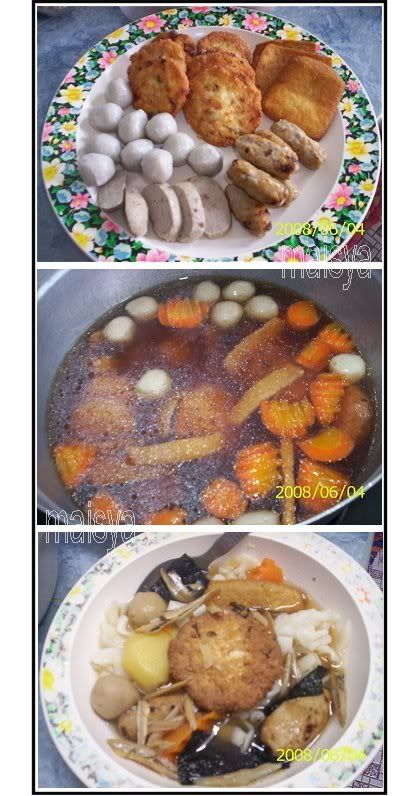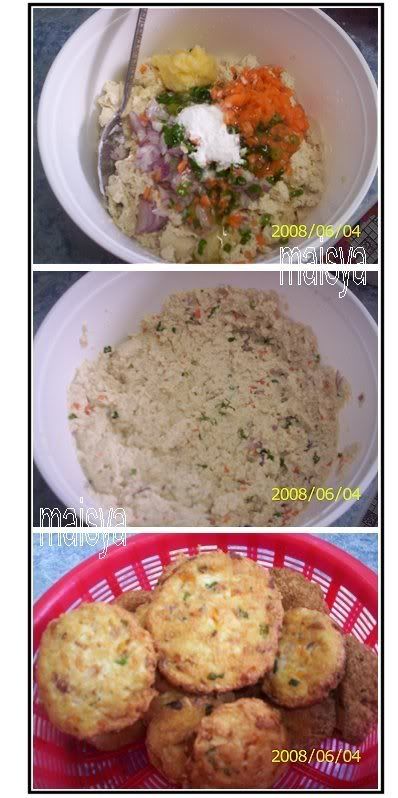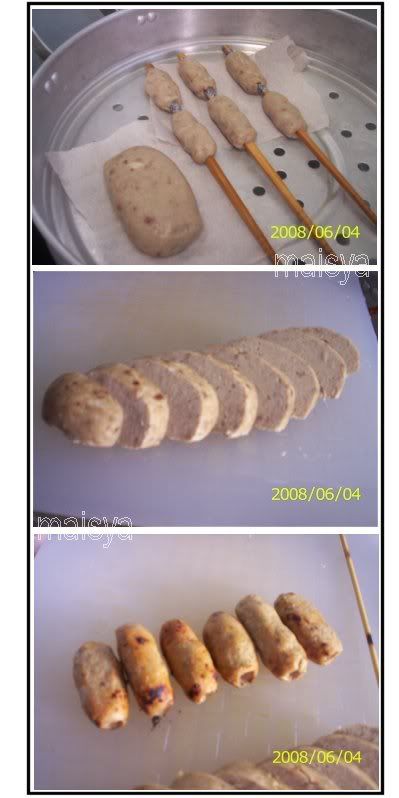Oden
 Oden ni sedap makan masa winter tapi kat malaysia bila-bila pun boleh je...ni lebih kurang macam Yong Tau Foo le. Selalunya kalau Jepun di supermarket tu dah jual paket-paket utk buat oden ni. Tinggal balik rumah masak supnya dan bubuh le segala benda dlm tu.
Oden ni sedap makan masa winter tapi kat malaysia bila-bila pun boleh je...ni lebih kurang macam Yong Tau Foo le. Selalunya kalau Jepun di supermarket tu dah jual paket-paket utk buat oden ni. Tinggal balik rumah masak supnya dan bubuh le segala benda dlm tu.Utk sup selalunya guna dashi, kicap je. So maisya just rebus ikan bilis lepas tu tambah le kicap sesedap rasa. Tambah garam dan gula kalau nak. Bahan-bahan kali ni maisya letak kentang & carrot(yg dah direbus separuh masak terlebih dulu), fishball(yg ni beli), ganmodoki, kamaboko, chikuwa, dan abura age.
Kamaboko dan chikuwa tu sebenarnya kena guna ikan yg isi putih tapi maisya buat guna ikan kembung jer...saja je nak try...kalau beli tenggiri tu mahal le plak. So rupa dan rasa dia tak sama le dgn yg sepatutnya. Chikuwa plak guna bahan yg sama dengan kamaboko cuma balut kat chopstick dan kukus lepas tu grill plak sekejap.
Abura age tu tak menjadik...resepi just suruh potong nipis tauhu, keringkan dan goreng. Tapi tak jadik le...tak mau dia mengembang cam yg sepatutnya...tapi tak pe still boleh makan lagik! Ha..ha..
Oden ni biasanya makan cam tu je or boleh le nak cicah dengan apa-apa tapi disebabkan bahan-bahannya sikit kali ni, kalau makan pon tak kenyang ... so maisya makan dengan udon...tambah nori/seaweed sikit. Itulah dinner kami semalam.
Malas nak mengarang ayat so just copy & paste info dari pelbagai sumber.
Oden is a Japanese winter dish consisting of several ingredients such as boiled eggs, daikon radish, konnyaku, and processed fish cakes stewed in a light, soy-flavoured dashi broth. Ingredients vary according to region and between each household
List of Popular Ingredients
Boiled eggs
Chikuwabu - gluten tubes. Popular in Kantō, virtually unknown elsewhere.
Sliced daikon
Suji - beef tendons
Ito konnyaku
Konnyaku
Carrot
Shiitake
Kabocha - Japanese squash
Potato
Tsukune - fish or meat balls
Octopus
Tofu products:
Ganmodoki - fried balls of tofu mixed with grated vegetables
Atsuage - deep fried tofu
Tofu - mainly in Kansai, usually seared
Surimi products:
Bakudan - boiled egg wrapped in surimi
Chikuwa - thick tubes of surimi
Gobomaki - boiled gobo (greater burdock root) wrapped in surimi
Hanpen
Ikamaki - squid wrapped in surimi
Kamaboko
Shinjoage - fried seafood paste
Extract from http://en.wikipedia.org/wiki/Oden
Oden is a Japanese winter dish consisting of several ingredients such as boiled eggs, daikon radish, konnyaku, and processed fish cakes stewed in a light, soy-flavoured dashi broth. Ingredients vary according to region and between each household
List of Popular Ingredients
Boiled eggs
Chikuwabu - gluten tubes. Popular in Kantō, virtually unknown elsewhere.
Sliced daikon
Suji - beef tendons
Ito konnyaku
Konnyaku
Carrot
Shiitake
Kabocha - Japanese squash
Potato
Tsukune - fish or meat balls
Octopus
Tofu products:
Ganmodoki - fried balls of tofu mixed with grated vegetables
Atsuage - deep fried tofu
Tofu - mainly in Kansai, usually seared
Surimi products:
Bakudan - boiled egg wrapped in surimi
Chikuwa - thick tubes of surimi
Gobomaki - boiled gobo (greater burdock root) wrapped in surimi
Hanpen
Ikamaki - squid wrapped in surimi
Kamaboko
Shinjoage - fried seafood paste
Extract from http://en.wikipedia.org/wiki/Oden

Ganmodoki or hiryouzu are small deep-fried fritters made of tofu and various ingredients. They are either eaten as-is or cooked in a broth
Utk sayurannya maisya just bubuh carrot, daun bawang dan bawang yg dicincang.
GANMODOKI
http://www.justhungry.com/ganmodoki-or-hiryouzu-japanese-tofu-fritters
400g / 10oz firm tofu, as fresh as possible
1 dried shiitake mushroom, reconstituted in water, squeezed dry, and finely chopped
2 Tbs finely grated (into shreds) carrot
2 Tbs finely chopped green onion
3 Tbs. finely grated (to a pulp) yamaimo or potato
1 egg white or egg white substitute
1 tsp. salt
1 Tbs. corn or potato starch
Oil for deep frying
Optional additions - choose one or several
1 Tbs. canned or blanched gingko nuts, roughly chopped or whole if you have tiny ones
1 Tbs. dried sakura ebi (tiny little shrimp)
1 Tbs. boiled edamame beans (don’t add both gingko and edamame, use one or the other)
1 Tbs. cooked hijiki
1-2 kikurage (tree-ear mushrooms), reconstituted in water, squeezed dry, and finely chopped (instead of the shiitake, or use 1/2 shiitake and 1/2 kikurage)
Drain the tofu, and wrap in a clean non-terrycloth kitchen towel. Place on a cutting board, then put another cutting board or similar flat item on top of the tofu. Place a weight on top (such as a small pan filled with water) and leave for about 15-20 minutes, to drain out some of the moisture from the tofu.
In the meantime, very briefly blanch the carrot in boiling water (about a minute).
If the tofu still feels a bit web, put the tofu in another cloth and squeeze very gently - you don’t want the tofu to be totally dry, it should be the texture of small curd cottage cheese. Mash up the tofu with your hands or with a potato masher.
Mix all the ingredients with or without the optional additions in a bowl, until it’s rather creamy.
Heat the oil to about 160°C / 320°F. Form the tofu mixture into small patties and fry 2-3 at a time (don’t overcrowd the frying pot).
Drain well, and serve immediately with soy sauce and mustard (karashi jo-yu). They are also pretty good at room temperature, so are great for obento

Kamaboko is made from white fish, which is filleted, pounded into a paste, mixed with a starch and molded into a variety of shapes. It can be steamed, deep fried, barbecued or poached. With its delicate taste and firm texture, it plays an important role in numerous Japanese recipes including Ozoni, other soups, noodles, simmered dishes, Oden, other casserole dishes, salads, and also makes an attractive and delicious appetizer.
Kamaboko also goes by many other names, based on the shape, cooking method and even geography. Chikuwa is formed in the shape of bamboo. Steamed Kamaboko is also called Sumaki or Mushiita. Fried Kamaboko is called Tenpura in West Japan and Satsuma Age in the Kanto District (East Japan).
Info taken from http://home.earthlink.net/~marutama/facts.htm
KAMABOKO
http://www.ajiwai.com/otoko/make/kamabo.htm
250g isi ikan tenggiri atau apa-apa ikan putih
15g tepung gandum
50ml air sejuk( dari peti ais )
5g garam
Ambil isi ikan dan rendam sekejap dlm air sejuk( dari peti sejuk ) utk hilangkan bau dan lebihan lemak/minyak. Toskan.
Bungkus isi ikan dalam kain dan perah untuk buang lebihan air.
Cincang isi ikan dengan pisau lebih kurang 10 minit atau boleh guna food processor kalau ada.
Tumbuk pula isi ikan menggunakan lesung batu selama 10 minit. Tambah tepung dan air garam. Sambung tumbuk lagi 10 minit.
Ambil isi ikan tu dan bentukkan 4 segi or bulat . Letak atas kertas minyak dan rehatkan dlm sejam.
Kukus 20-30 minit.Sejukkan dan potong-potong bila nak digunakan.
Ulasan
saja-saja je cuba buat...tapi kalau time fuyu lebih suka buat nabe lagik...makan ramai-ramai.
i sukeee sgt japanese...kalu nk mkn kt restaurant cam x yakin jekkk... tgk oden tuh cam tingin sgt2 nk cuba.... ikshh sedap tuii tekak ni kalu buleh hirup sup panas2..
maisya suka cuba je...kalau yg renyah tu biasanya buat sekali jer le..he...he..
shima,
memang payah sebab Japanese suka letak mirin dalam masakan...bila nak belajar buat sendiri, cari resepi barulah tahu apa sebenarnya yg depa letak dlm tu
kak pinat,
maisya malas masak lauk tau..he..he..
akak pun masa dok sana tak pandang masakan jepun ni sgt...bila balik sini baru try buat.